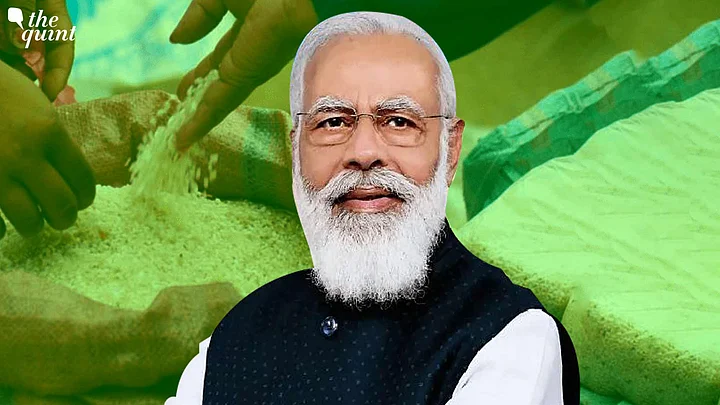India’s Foreign Minister Jaishankar tweeted a critical cabinet announcement of the Modi government that may have little to do with India’s foreign policy, but probably a lot with domestic affairs and the BJP’s 2024 Lok Sabha campaign.
The government has decided to make free food grains available to more than 800 million beneficiaries till December 2023 under the National Food Security Act(NFSA). It will also spend two trillion rupees (USD 24.2 billion) more on the scheme.
The Union government’s decision to provide free ration as part of FSA was first undertaken during the later part of 2020 at the heart of the Covid-induced lockdown when the poor, less privileged, and those part of the informal sector, were struggling to make their ends meet, or even afford two meals a day, largely as a result of the sufferings imposed from (an ill-conceived) nationwide, curfew-style lockdown.
Free Ration Scheme Propelled BJP’s Big Win in UP
Despite multiple deadlines on the ration distribution ending, the Modi government continued to extend the scheme from 2020 in order to project its goal to ‘take care’ of the poor and needy throughout the pandemic.
The fiscal burden of the measure, as important as it is, maybe less relevant to deliberate on here, particularly when the policy move is solely viewed from the chronic state of poverty and its accentuation observed during Covid across India which directly impacts access to basic nutrition and food availability for the poor.
It is also fair to analyse this measure in the context of BJP’s electoral campaigns in Uttar Pradesh(UP) and other states where it was fighting different assembly elections.
The BJP did win big in UP, and one of the key electoral factors influencing the pro-BJP vote amongst the poor was the successful delivery of ‘free ration’ throughout the pandemic years ie in the latter half of 2020, 2021, and early 2022. Our own research team also analysed this in our ethnographic election field survey study undertaken in rural and semi-urban UP (see video essays here).
Still, most policy economists now anticipated the ‘free ration distribution scheme’ to be terminated by the end of this year. The announcement to extend the scheme by another year now may come across as a surprise and a probable move indicating the Modi Government’s continuance in employing this as part of BJP’s 2024 Lok Sabha plan.
Nutrition Crisis & Poverty Alleviation Among Govt’s Key Challenges
Projecting an ambitious rollout of ‘free ration for more than 800 million poor beneficiaries’ from 2020 to 2023 may allow the incumbent government to present a ‘narrative of welfare centrism’ in its record for its second term and accrue more votes in favour of the incumbent government.
The BJP-ruled states including UP and MP have also implemented the scheme better (for similar ‘political economy of vote’ reasons).
Another key facet of this measure is to view this policy move in the larger context of the macro ‘crisis of nutrition’ and ‘increased poverty’ facing the nation at this point, which it seems the government too seems to realise (if not willing to discuss it as an issue).
The last few years have seen India’s macro-growth processes to be weak; domestic private investment to be low; a dismal state of aggregate demand and job creation, while, rural poverty, along with urban poverty, increased throughout the covid period (and as we know from Dreze and Sen’s earlier work studying poverty: nutrition and poverty levels are closely entwined).
While the Union government failed to sufficiently spend more on most revenue-focused welfare schemes despite its inability to get the much-needed economic recovery process to be sustained (remember the government’s justification to spend less on revenue expenditure was that it wanted a ‘pro-growth’ CapEx-driven budget which clearly didn’t translate in sustained high growth), on macro and micro-level nutritional access, the scenario has remained consistently poor.
Note, India’s low-ranked performance in the Global Hunger Index(GHI) 2022. And, if one subscribes to the observers who doubt GHI’s methodology (as the Government does), the following facts for reference may through some light:
“The UN data for 2020 estimated nearly a billion Indians were unable to purchase a wholesome, nourishing diet. And a recent study found more than two-thirds of India’s rural population could not afford a diet that met India’s own dietary guidelines. More than half of respondents in a December 2021-January 2022 survey said they ate fruits, fresh foods, eggs, or milk fewer than two or three times a month, while four in five respondents said the nutritional quality of the food they consumed had deteriorated since the pandemic.”
Can Free Ration Meet India’s Food Deficit in Children & Young Adults?
For a country looking to reap the financial benefits of its growing young workforce, the economic implications of malnutrition among Indian children, adolescents, and working-age adults are as significant as the costs for health and quality of life.
Rates of stunting among pre-schoolers—a key marker of chronic undernutrition fell substantially from 48 percent in 2005-06 to 38.4 percent in 2015-16. But by 2019-21, progress against stunting had slowed, falling less than three percentage points to 35.5 percent.
Moreover, one in five children in India is too thin — a statistic that has barely moved since the early 1990s. It’s one of the highest rates globally and a major risk factor for child mortality. All of this highlights the chronic state of poor nutritional access and also its combined effect with India’s poor growth and developmental performance, which makes the macro and micro socio-economic scenario for India’s poor and low-income groups even more hopeless.
To read the Counterview on Govt's Free Food Extension under NFSA, click here.
(The author is Associate Professor of Economics, OP Jindal Global University. He is currently Visiting Professor, Department of Economics, Carleton University. He tweets @Deepanshu_1810. This is an opinion piece and the views expressed above are the author’s own. The Quint neither endorses nor is responsible for the same.)
